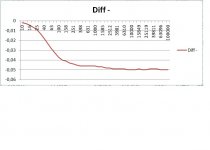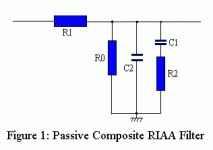What I like about PH-77 and Graham Slee's Jazz Club EQ is that they provide a consistent and non-variant setting for adjusting playback of LPs, whether Mono or Stereo. I have had good experiences with Melodiya USSR pressings, and I like that they made a special DMM-EQ, as I have a number of those.
But it appears that the quite sweeping claim about non-RIAA being used into the 70s, and DGG doing their own thing for years, is hard to substantiate.
No matter - I prefer this mode of adjustment - but feel I can relax as to whether my LPs are all over the place.
But it appears that the quite sweeping claim about non-RIAA being used into the 70s, and DGG doing their own thing for years, is hard to substantiate.
No matter - I prefer this mode of adjustment - but feel I can relax as to whether my LPs are all over the place.
Hi,
I too agree with all this.
But I have found enough evidence, including what got me started on this first case, actual vinyl.
I did (without even knowing Peter Copeland's work) the same as he recommends# (freely available EQ) and kept comming up with numbers I recognised...
Ciao T
# See: MANUAL OF ANALOGUE SOUND RESTORATION TECHNIQUES, Page 166, Section 6.74, he recommends three fully variable time constants, such as for example found on the FM Acoustics Phono's, however most Consumers and Audiophiles struggle with such extreme flexibility...
Yes, I agree that the claim made about stereo LP's is extremely contentious and my first instinct would be to dismiss it.
I too agree with all this.
But I have found enough evidence, including what got me started on this first case, actual vinyl.
I did (without even knowing Peter Copeland's work) the same as he recommends# (freely available EQ) and kept comming up with numbers I recognised...
Ciao T
# See: MANUAL OF ANALOGUE SOUND RESTORATION TECHNIQUES, Page 166, Section 6.74, he recommends three fully variable time constants, such as for example found on the FM Acoustics Phono's, however most Consumers and Audiophiles struggle with such extreme flexibility...
Ok, from the Stereophile review: PH-77. The secret curves.
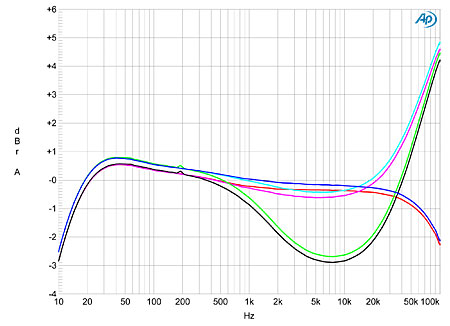
Red-blue: RIAA
Cyan-Magenta: "Enhanced RIAA" (freq response is relative to RIAA)
Green-Black: "RIAA DMM" (freq response is relative to RIAA)
The "Enhanced RIAA" is within 0.5dB of the RIAA curve at the audible range. Thus it's basically the same thing. Nice.
The "RIAA DMM" is within 3dB of RIAA so basically is a subtle change, a matter of taste.
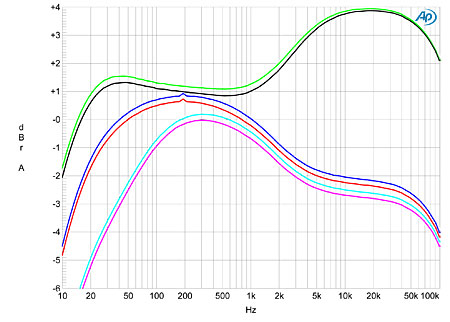
Red-blue: "Decca FFSS (stereo)" (curve relative to RIAA)
Cyan-Magenta: "Columbia"
Green-Black: "CCIR 56"
"Decca FFSS" is within 2dB of RIAA. A slight tonal change. But certainly no difference that could be caused by using significanty different time constants (relative to RIAA)
"Columbia": Same comments as above.
"CCIR 56": This one is different indeed.
This is my point of contention: The "Enhanced RIAA", "RIAA DMM", and "DECCA FFSS stereo" are basically very subtle variations of the standard RIAA curve. Thus we can't say thus records were cut using "a different standard". A mastering EQ, used at will by the mastering engineer, will vary the final EQ much more than the difference between AMR's "Decca FFSS stereo" and plain vanilla RIAA curves.
I understand that CCIR 56 is different and ThorstenL may as well have a good point in saying that some records on the eastern countries might have used CCIR 56 instead of RIAA. But the other "curves" should not be claimed as EQ curves that significantly deviate from the RIAA standard, and this is what i don't like about the publicity on the AMR website.
On the other hand, Telemann and others raise a point i fully agree with: It's very hard to believe that Deutsche Grammophon wasn't using the RIAA standard from the beginning. Unless we get specific examples. But i have early 60's stereo records from them and they play just fine with the standard RIAA eq.
Last edited:
Yes, I agree that the claim made about stereo LP's is extremely contentious and my first instinct would be to dismiss it. Nevertheless it cannot be denied that the earliest Decca FFSS LP's sound really quite different from their reissues in quite a consistent way and one might say the same about DGG.
Yes, because they were cut in a funny way (half speed and with a very early stereo cutting head) before they switched to real-time cutting and the Neumann SX 68 head. The half-speed cutting required some tweaks as i've described before:
http://www.diyaudio.com/forums/analogue-source/188876-riaa-equalization-standard-10.html#post2585729
Check out the PDF i've referenced. Personally, i think that the bass on those FFRR records is just fine. Additionally, any mechanical transducer will have its own 'signature' sound, even more if we switch from a early head with a 90º armature (Telefunken-Decca ZS 90/45) to a modern helium-cooled 45º-45º coil arrangement head (Neumann SX 68).
Different resonant frequencies too; any cutting head will have resonances and they will be flattened out by the feedback system. But this doesn't mean their "sonic signature" will be gone; a waterfall plot would still show the different resonances being there, despite the frequency response curve testing flat when tested in a normal way (pink noise test, frequency sweep, etc.) The same happens with speakers which test with similar freq responses but have a markedly different sound or 'coloration': the waterfall plot shows the difference.
Last edited:
This is my point of contention: The "Enhanced RIAA", "RIAA DMM", and "DECCA FFSS stereo" are basically very subtle variations of the standard RIAA curve.
Not so subtle.
I can distinctly hear differences of 0.05dB produced by the variation of a single resistor in my riaa preamp.
AMR curves show much larger differences.
In attach you can see the difference by adjusting main resistor from 46020 to 46284r in my passive riaa build.
I wanted more attack and byte and that is what I got in this case. The difference is very small in dB but clearly audible.
Attachments
Hi,
Well, first if they are subtle or not is a sentiment open to doubt.
It is all good and well to debate this from the armchair, asserting "Any rumours of the existence of the abominable snowman are exaggerated."
However, unlike in the case of the "abominable snowman", with the whole EQ story it is easy to test for oneself. So I can only recommend the "TIYS" method, it is more informative and eloquent by far than twenty pages of debate.
Ciao T
This is my point of contention: The "Enhanced RIAA", "RIAA DMM", and "DECCA FFSS stereo" are basically very subtle variations of the standard RIAA curve.
Well, first if they are subtle or not is a sentiment open to doubt.
It is all good and well to debate this from the armchair, asserting "Any rumours of the existence of the abominable snowman are exaggerated."
However, unlike in the case of the "abominable snowman", with the whole EQ story it is easy to test for oneself. So I can only recommend the "TIYS" method, it is more informative and eloquent by far than twenty pages of debate.
Ciao T
This thread that I Started was not intended to be a debate of weather it's worth implementing or if it makes a sonic difference....
it was merely opened to shed some light on just how wide the spread in different emphasis curves really are....Some may think it doesn't and others may believe it's one very relevant feature of a good Riaa..
Once knowing the spread...it could be posse to implement it with fixed caps and viable resistors...
it was merely opened to shed some light on just how wide the spread in different emphasis curves really are....Some may think it doesn't and others may believe it's one very relevant feature of a good Riaa..
Once knowing the spread...it could be posse to implement it with fixed caps and viable resistors...
Hi.
That what we did at AMR. Most of the curves we have implemented are documented widely, where the where questions we researched further, in some cases rather far.
Ciao T
Once knowing the spread...it could be posse to implement it with fixed caps and viable resistors...
That what we did at AMR. Most of the curves we have implemented are documented widely, where the where questions we researched further, in some cases rather far.
Ciao T
I can distinctly hear differences of 0.05dB produced by the variation of a single resistor in my riaa preamp.
I don't think so.
Just switching your listening position a few inches, will change the FR up to 6dB on certain effects due to the comb filtering created by room walls reflections... And most people would say this does 'nothing' to the sound.
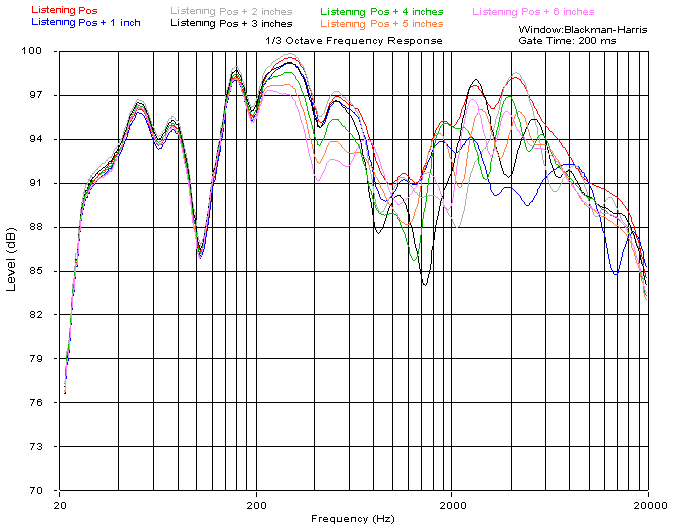
I wanted more attack and byte and that is what I got in this case. The difference is very small in dB but clearly audible.
You got more "bite and attack" because of the placebo effect and confirmation bias: You wanted to create a difference, you believed changing the resistor would make a difference --> thus your brain confirms that there's a difference, even if objectively isn't it.
But please don't take it as a personal offense. Everyone of us suffer from confirmation bias sometimes. And the placebo effect is real. Ask doctors. If it wasn't for the placebo effect, people wouldn't 'hear' benefits reversing the direction of speaker cables, etc.
Now, the changes i label as "subtle" on the curves that are variations of RIAA will be audible, i don't contend that. But 0.05dB is another thing altogether.
You are all probably aware of LCR passive RIAA equalisation networks (vs. the more common CR networks). A number of high-end phono stages use them (eg. the Allnic) and AIUI, they generally state their RIAA equalisation curve is within 0.5dB!  (Whereas the customary LC-based RIAA equalisation is typically stated as +/-0.1 or 0.2dB.)
(Whereas the customary LC-based RIAA equalisation is typically stated as +/-0.1 or 0.2dB.)
Surely, if 0.05dB variations were actually "hearable", no-one would buy LCR phono stages?
So I would suggest even 0.2dB variations are below most people's hearing acuity?
Regards,
Andy
Surely, if 0.05dB variations were actually "hearable", no-one would buy LCR phono stages?
So I would suggest even 0.2dB variations are below most people's hearing acuity?
Regards,
Andy
You can just barely hear 0.2dB differences in direct comparisons. Difficult to impossible otherwise. 0.05dB, probably not even in direct comparison.
EQ errors are much easier to pick up when they're interchannel; in my preamps, I match channel to channel as tight as I can and don't sweat a few tenths of a dB overall. If I were doing it commercially, I'd want to match unit to unit a bit tighter.
EQ errors are much easier to pick up when they're interchannel; in my preamps, I match channel to channel as tight as I can and don't sweat a few tenths of a dB overall. If I were doing it commercially, I'd want to match unit to unit a bit tighter.
I am using a passive riaa like the one in attach.
Where the initial values where:
R0 = 1M
R1 = 44910r
R2 = 6730r
C1 = 47.25nF
C2 = 15.33nF
Main R is a combination of R0, R1 and the 1st stage ouput impedance.
C2 depends on the miller of second stage and some other aspects.
By increasing R1 from 44910 to 45170 (a small 260r difference) I can distinctly hear the difference.... More snap and attack. We can not increase this resistance too much otherwise the sound will become edgy.
The graph I posted was obtained using spice simulations, just altering the Main R.... maybe these simulations do not reflect reality and the value 0.05dB is in fact larger....
I can also hear distinctly a 10pF variation on the trebble cap C2 = 15.33nF.
For instance, to get the correct 318uS mid pole I needed to find the exact values for R2 and C1 (6730 x 0.04725) .. any deviation from that alter the timbre of the instruments.
I understand most people have hard ears and maybe that is why most equipment are sold on the ownership pride basis and not based on the subjective listening impressions. In this way a Vitus should sound better than a ASR Basis just because it "is better".
I just posted my graph because someone wrote that the differences between the several curves in Thorsten´s machine were negligible and I believe these differences are VERY audible indeed.
Where the initial values where:
R0 = 1M
R1 = 44910r
R2 = 6730r
C1 = 47.25nF
C2 = 15.33nF
Main R is a combination of R0, R1 and the 1st stage ouput impedance.
C2 depends on the miller of second stage and some other aspects.
By increasing R1 from 44910 to 45170 (a small 260r difference) I can distinctly hear the difference.... More snap and attack. We can not increase this resistance too much otherwise the sound will become edgy.
The graph I posted was obtained using spice simulations, just altering the Main R.... maybe these simulations do not reflect reality and the value 0.05dB is in fact larger....
I can also hear distinctly a 10pF variation on the trebble cap C2 = 15.33nF.
For instance, to get the correct 318uS mid pole I needed to find the exact values for R2 and C1 (6730 x 0.04725) .. any deviation from that alter the timbre of the instruments.
I understand most people have hard ears and maybe that is why most equipment are sold on the ownership pride basis and not based on the subjective listening impressions. In this way a Vitus should sound better than a ASR Basis just because it "is better".
I just posted my graph because someone wrote that the differences between the several curves in Thorsten´s machine were negligible and I believe these differences are VERY audible indeed.
Attachments
As I pointed before, my Spice simulations only take in consideration the riaa filter and not the complete preamp.
Maybe the modifications that produce so clearly heard differences also affect other aspects in the complete amp and so can produce higher deviations in the response.
Anyway, I recently had the oportunity to evaluate the AMR phono and the different EQ curves produce clearly audible differences.
Maybe the modifications that produce so clearly heard differences also affect other aspects in the complete amp and so can produce higher deviations in the response.
Anyway, I recently had the oportunity to evaluate the AMR phono and the different EQ curves produce clearly audible differences.
As I pointed before, my Spice simulations only take in consideration the riaa filter and not the complete preamp.
Maybe the modifications that produce so clearly heard differences also affect other aspects in the complete amp and so can produce higher deviations in the response.
Far more likely than the minuscule frequency deviation, yes.
Well, first, it actually is. Setting up a Blind test that is meaningful is not easy at all. As for the ones showing null results, I know of no tests that I would credit with having any statistical power or exhibiting a methodology that would not force anyone who understands statistics and ALL the issues in blind testing to throw them out as badly implemented.
Really? You can’t step back and isolate a single issue (silver foil caps, resistors, etc.) and suggest a scenario where we could all benefit. These stories smack a little of elitism. I know instrument makers, musicians, and recording engineers that don’t subscribe to these component “sonic” issues even after decades of accumulated experience in living, breathing, and making music. This includes principles in the BSO (retired). Not one of the proverbial “friends in the room” didn’t hear anything? I trust you did do due diligence, but dropping this story in like this just acts like a lifeboat in the sea of totally random anecdotal claims made here.
Funnily enough, if blind tests are carried out the way they are in clinical medicine and pharmaceutical research (e.g. Ackerman, Oohasi et el) do show positive results.
Don’t know Ackerman (link) but Oohasi is a bad example, there are no claims concerning anything un-measurable here. Their stimuli were carefully quantified. Of course the equipment used was probably filled with “garbage” (by audiophile standards) components, I wonder if ALL (your emphasis) the issues were considered.
As for dumping out wine with plastic corks, I hope you realize how few had anything to do with SY’s studies. I don’t think he meant to validate claims made by his competitors. There were unfortunately very few plastic closures from Neocork. Did you check?
As an aside, I wish the mods would stop the unprofessional attacks on SY’s personal business outside of audio.
Sy,
Not at all, I was actually expecting you to provide the correction.
This we both find ourselves in agreement with. I have found null results where I did not expect them and I have equally found persistent "different" results where I did not (generally things I expected to be "too far below the noisefloor to matter").
Absolutely.
Ciao T
And you just repeat the incorrect premise. How does that make it more correct?
Not at all, I was actually expecting you to provide the correction.
To be clear (because there's an analogy to audio, and when you're designing a piece of equipment for audible performance, you want to test for audible performance): over the course of 12 years in that business, I set up, ran, and analyzed about 1,000 or so controlled subjective tests. Some tests showed differences, some tests didn't. It depends on the variable being tested. That's the important point of controlled subjective tests- it's a tool for the designer, and as well, it provides a way of verifying claimed performance to back up marketing efforts.
This we both find ourselves in agreement with. I have found null results where I did not expect them and I have equally found persistent "different" results where I did not (generally things I expected to be "too far below the noisefloor to matter").
For most variables, they really aren't that terribly difficult to do properly, no harder than any other audio project. The basic principles are the same, whether you're doing haptic, organoleptic, or auditory.
Absolutely.
Ciao T
Hi,
I don't particularly care about silver foil capacitors or resistors. However quite a few of these things have real measurable effects (e.g. thickfilm vs. thinfilm resistors, microphonics in capacitors etc.).
This is a very good example of how to carry out tests.
I do not cite any tests to support "magical" resistors (no need for magic, observable differences exist anyway), I cite them to illustrate how DB tests should be done.
Past that, I referred to Sy's cork studies because he himself has previously cited them in the context of DB Test debates in audio... So this is hardly an attack on his professional work.
Ciao T
Really? You can’t step back and isolate a single issue (silver foil caps, resistors, etc.) and suggest a scenario where we could all benefit.
I don't particularly care about silver foil capacitors or resistors. However quite a few of these things have real measurable effects (e.g. thickfilm vs. thinfilm resistors, microphonics in capacitors etc.).
Don’t know Ackerman (link) but Oohasi is a bad example, there are no claims concerning anything un-measurable here. Their stimuli were carefully quantified. Of course the equipment used was probably filled with “garbage” (by audiophile standards) components, I wonder if ALL (your emphasis) the issues were considered.
This is a very good example of how to carry out tests.
I do not cite any tests to support "magical" resistors (no need for magic, observable differences exist anyway), I cite them to illustrate how DB tests should be done.
Past that, I referred to Sy's cork studies because he himself has previously cited them in the context of DB Test debates in audio... So this is hardly an attack on his professional work.
Ciao T
Hi,
I do not cite any tests to support "magical" resistors (no need for magic, observable differences exist anyway), I cite them to illustrate how DB tests should be done.
Ciao T
Observable differences in the context of high quality metal film vs. Vishay naked or whatever? Are we talking the -130dB vs. -140dB thermal non-linearities? I could find 6 or 8 examples of as you say not measurable by AP etc. that have advocates making the "wife in the other room" testimonials.
If your tests are not to justify bespoke (AMR's word) components and a $17,000 build vs an off the shelf one what are they for?
I never used the word magic.
Scott,
I stated specifically Thinfilm vs. Thickfilm.
I have several of these that we found to give a different result in a blind test, no need of the wife in the other room.
They are for ascertaining if a given circuit/component change actually makes an audible change or not and if so, which version is preferable. This extends to subjects like passive components or circuit topologies and even PCB layouts.
AMR use a lot of bespoke components, simply because we order normally quantities where it is possible and there are usually improvements to the production process that can be applied at nominal costs (like deliberate airgaps in transformer cores and electrostatic screens), thicker metal foil in Foil/Film Capacitors and such changes.
FWIW, AMR once made a specific design change which we had not fully tested and auditioned extensively. The difference was quite small, but we had a number of dealers and distributors complained the new units did not sound as good as the old ones (without being told there was any difference), generally giving similar descriptions as to the differences, from Korea to the USA and what lies inbetween. Note, this was not a test, just a normal running change and replacing a supposedly identical part from one source with a different one.
When the change was identified and reversed (again without telling the customers) we had strong requests to provide means to bring the other units to the same specs. Of course, maybe all these people all just had mass hallucinations. Maybe they where all psychic and where exchanging information that way, maybe they where just having all a good practical joke at our expense?
In another case we went from a high quality socket for one IC to direct soldering and a number of our partners started raving how much better the new units where and wanted upgrade for existing ones. Of course, old and new measured identical, but they sounded different.
I did. I used "magical" as a shorthand for "percieved effect not explainable by the laws of physics".
Ciao T
Observable differences in the context of high quality metal film vs. Vishay naked or whatever? Are we talking the -130dB vs. -140dB thermal non-linearities?
I stated specifically Thinfilm vs. Thickfilm.
I could find 6 or 8 examples of as you say not measurable by AP etc. that have advocates making the "wife in the other room" testimonials.
I have several of these that we found to give a different result in a blind test, no need of the wife in the other room.
If your tests are not to justify bespoke (AMR's word) components and a $17,000 build vs an off the shelf one what are they for?
They are for ascertaining if a given circuit/component change actually makes an audible change or not and if so, which version is preferable. This extends to subjects like passive components or circuit topologies and even PCB layouts.
AMR use a lot of bespoke components, simply because we order normally quantities where it is possible and there are usually improvements to the production process that can be applied at nominal costs (like deliberate airgaps in transformer cores and electrostatic screens), thicker metal foil in Foil/Film Capacitors and such changes.
FWIW, AMR once made a specific design change which we had not fully tested and auditioned extensively. The difference was quite small, but we had a number of dealers and distributors complained the new units did not sound as good as the old ones (without being told there was any difference), generally giving similar descriptions as to the differences, from Korea to the USA and what lies inbetween. Note, this was not a test, just a normal running change and replacing a supposedly identical part from one source with a different one.
When the change was identified and reversed (again without telling the customers) we had strong requests to provide means to bring the other units to the same specs. Of course, maybe all these people all just had mass hallucinations. Maybe they where all psychic and where exchanging information that way, maybe they where just having all a good practical joke at our expense?
In another case we went from a high quality socket for one IC to direct soldering and a number of our partners started raving how much better the new units where and wanted upgrade for existing ones. Of course, old and new measured identical, but they sounded different.
I never used the word magic.
I did. I used "magical" as a shorthand for "percieved effect not explainable by the laws of physics".
Ciao T
- Status
- This old topic is closed. If you want to reopen this topic, contact a moderator using the "Report Post" button.
- Home
- Source & Line
- Analogue Source
- RIAA Equalization Standard...
